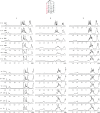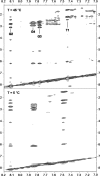Synthesis and structural characterization of stable branched DNA g-quadruplexes using the trebler phosphoramidite
- PMID: 24551498
- PMCID: PMC3922461
- DOI: 10.1002/open.201200009
Synthesis and structural characterization of stable branched DNA g-quadruplexes using the trebler phosphoramidite
Abstract
Guanine (G)-rich sequences can form a noncanonical four-stranded structure known as the G-quadruplex. G-quadruplex structures are interesting because of their potential biological properties and use in nanosciences. Here, we describe a method to prepare highly stable G-quadruplexes by linking four G-rich DNA strands to form a monomolecular G-quadruplex. In this method, one strand is synthesized first, and then a trebler molecule is added to simultaneously assemble the remaining three strands. This approach allows the introduction of specific modifications in only one of the strands. As a proof of concept, we prepared a quadruplex where one of the chains includes a change in polarity. A hybrid quadruplex is observed in ammonium acetate solutions, whereas in the presence of sodium or potassium, a parallel G-quadruplex structure is formed. In addition to the expected monomolecular quadruplexes, we observed the presence of dimeric G-quadruplex structures. We also applied the method to prepare G-quadruplexes containing a single 8-aminoguanine substitution and found that this single base stabilizes the G-quadruplex structure when located at an internal position.
Keywords: 8-aminoguanines; DNA structures; G-quadruplexs; branched oligonucleotides; oligonucleotides.
Figures






Similar articles
-
Synthesis and characterization of monomolecular DNA G-quadruplexes formed by tetra-end-linked oligonucleotides.Bioconjug Chem. 2006 Jul-Aug;17(4):889-98. doi: 10.1021/bc060009b. Bioconjug Chem. 2006. PMID: 16848394
-
DNA G-Quadruplex in Human Telomeres and Oncogene Promoters: Structures, Functions, and Small Molecule Targeting.Acc Chem Res. 2022 Sep 20;55(18):2628-2646. doi: 10.1021/acs.accounts.2c00337. Epub 2022 Sep 2. Acc Chem Res. 2022. PMID: 36054116 Free PMC article.
-
Intramolecular and intermolecular guanine quadruplexes of DNA in aqueous salt and ethanol solutions.Biopolymers. 2007 May;86(1):1-10. doi: 10.1002/bip.20672. Biopolymers. 2007. PMID: 17211886
-
Fluorescence resonance energy transfer in the studies of guanine quadruplexes.Methods Mol Biol. 2006;335:311-41. doi: 10.1385/1-59745-069-3:311. Methods Mol Biol. 2006. PMID: 16785636 Review.
-
G-quadruplexes as targets for drug design.Pharmacol Ther. 2000 Mar;85(3):141-58. doi: 10.1016/s0163-7258(99)00068-6. Pharmacol Ther. 2000. PMID: 10739869 Review.
Cited by
-
In What Ways Do Synthetic Nucleotides and Natural Base Lesions Alter the Structural Stability of G-Quadruplex Nucleic Acids?J Nucleic Acids. 2017;2017:1641845. doi: 10.1155/2017/1641845. Epub 2017 Oct 18. J Nucleic Acids. 2017. PMID: 29181193 Free PMC article. Review.
-
New G-Quadruplex-Forming Oligodeoxynucleotides Incorporating a Bifunctional Double-Ended Linker (DEL): Effects of DEL Size and ODNs Orientation on the Topology, Stability, and Molecularity of DEL-G-Quadruplexes.Molecules. 2019 Feb 12;24(3):654. doi: 10.3390/molecules24030654. Molecules. 2019. PMID: 30759875 Free PMC article.
-
Synthesis of 2'-O-Methyl/2'-O-MOE-L-Nucleoside Derivatives and Their Applications: Preparation of G-Quadruplexes, Their Characterization, and Stability Studies.ACS Omega. 2023 Nov 13;8(47):44893-44904. doi: 10.1021/acsomega.3c06231. eCollection 2023 Nov 28. ACS Omega. 2023. PMID: 38046329 Free PMC article.
References
LinkOut - more resources
Full Text Sources
Research Materials

